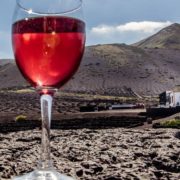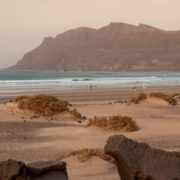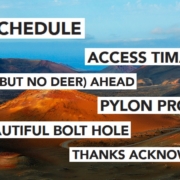The LZ-30 road from Uga to San Bartolomé is the main artery of Lanzarote’s wine country, a picturesque route that is essential for the understanding of the history and culture of this unique industry.
To the south of the road is the long, tall chain of ancient volcanoes – Tinasoria, Guardilama, Guatisea, and Montaña Blanca – that form the backbone of the island. They are an imposing barrier that protected towns and villages such as Mácher, Tías and La Asomada from the eruptions of the 1730s.
To the north are the results of those eruptions – a huge ocean of volcanic ash and picón (gravel) lapping against the flanks of smaller volcanoes. This was once the “breadbasket of the Canaries”, a place that supported several small villages and hamlets which grew wheat and barley and other crops. Now, those villages now lie permanently submerged beneath the sea of picón, which is studded with thousands of strange horseshoe patterns, all pointing in the same direction.
It’s a mystical, strange landscape that is unique to Lanzarote, and it reflects the ingenuity, persistence and sheer hard labour of the islanders.
For several years after the eruptions, nothing was grown in La Geria. Although no one died, the terrified locals had all moved to different parts of the island or emigrated, and the area was a seemingly barren wasteland. Decades later local farmers suddenly discovered that volcanic picón formed an excellent topsoil for cultivation, rich in minerals and capable of retaining moisture. The picón was carried to plots all over the island and is still used for this purpose.
It made sense to exploit La Geria itself, but the picón was too deep to plant smaller crops. Deep pits had to be dug to reach the soil below, and this back-breaking work wasn’t worthwhile unless the crops provided a profitable, regular yield. Some fruit trees fitted the bill, but the best candidate was the grapevine.
Unlike European vines which are trained to climb up sticks and trellises, those on Lanzarote lie low, avoiding the withering winds. Some of the vines in La Geria are over 100 years old, and each vine occupies its own pit, which can be up to two metres deep. For added shelter, a low, horseshoe shaped wall called a zoco or soco is built around the windward side of the pit.
Vines are pruned hard in January, when plumes of smoke from the resulting bonfires can be seen all over La Geria. The vine is then carefully cultivated until July, when the harvest begins. While modern irrigation, fertilisers and pesticides have certainly made the farmers’ task easier, most of the work of pruning, caring for the vine and harvesting is still carried out by hand, with several islanders finding casual work during the harvest.
At Bodegas La Geria, the harvest is celebrated every 15th August at the Fiesta de Nuestra Señora de la Caridad. This is when workers dress in traditional peasant costume and head to the zocos with camels, loading up the old wooden crates that were used in the past. The crates are brought back to the bodega, weighed on an antique scale and then tipped into a stone vat, where visitors are later invited to remove their footwear and tread the grapes in the old-fashioned way.
After this, a mass is held in the little white church nearby, which was once buried entirely in volcanic ash. Then the festivities begin in earnest.











Leave a Reply
Want to join the discussion?Feel free to contribute!